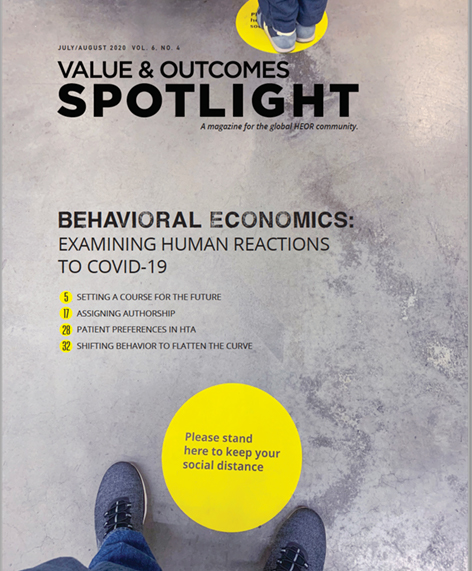Quality of Life of Patients and Caregivers
Validity and Responsiveness of Preference-Based Quality-of-Life Measures in Informal Carers: A Comparison of 5 Measures Across 4 Conditions
Value Health. 2020;23(6):782-790Section Editors: Soraya Azmi, MBBS, MPH, Beigene, USA; Agnes Benedict, MSc, MA, Evidera, Budapest, Hungary
Caregiver burden can be a significant problem for diseases that affect the very young or elderly. Hence therapies that improve those conditions could improve quality-of-life (QoL) of patients as well as their carers. However, quantifying caregiver burden has been traditionally difficult. Large prospective observational studies investigate and quantify costs and resource use for Alzheimers’ disease (eg, GERAS study). The QoL side of the burden is more challenging where, perhaps outside of Alzheimer’s disease, little preference-based information exists and there is also an uncertainty about which methods are best.1
There are a number of quality of life measures used to assess informal carers’ QoL: the ICEpop CAPability measure for Adults (ICECAP-A) is generic QoL measure that can pick up care-related and HRQoL issues; specifically care-related QoL measures include the Carer Experience Scale (CES), the CarerQoL-7D, and the Adult Social Care Outcomes Toolkit for Carers (ASCOT-Carer) are designed for use in economic evaluations and set of preference weights have been generated in a number of countries. Of course, the EQ-5D-5L is also an option to measure the HRQoL of caregivers.
The authors of the paper set out to examine the performance of the above measures in terms of construct validity and responsiveness. They conducted a de novo study including informal caregivers for patients across five prevalent diseases that often require informal caregiver support: dementia, stroke, mental illness, and rheumatoid arthritis.
"The paper provides a rich set of results that will be helpful for health researchers trying to identify and select measures to be included in studies to measure caregiver quality of life."
A sample of informal caregivers were drawn from three waves of the UK Family Resources Survey, between 2013 and 2016. The authors created a conceptual mapping of the QoL measures. They used that to create a survey that provided a structured framework that the measures can be assessed against. These constructs were grouped into three categories: the carer, the care recipient, and the caring situation. The latter included the extent of the care per week, the relationship between the carer and caregiver, among others.
Participants were invited to fill in a baseline survey and followed up at 12 months. Follow-up was dependent on the care situation: if someone stopped care for the baseline care recipients, they were asked to complete the 2 generic QoL measures 12 month post baseline; participants who remained in the caring role were asked to complete all QoL measures and contextual questions related to the carer, the care recipient, and the caring situation.
Overall, 576 carers responded to the baseline survey, mostly female (65%), mean age of 62 (SD=11); 46% caring for a parent and 35% for a partner; care recipients were on average 74. The QoL surveys At follow-up, QoL surveys were filled by 314 (75%) patients, with high completion rate (96-98%). Construct validity was tested based on prespecified evidence-based hypotheses. Responsiveness was evaluated using two anchor variables: the HRQoL of the care recipient and the hours of informal care provided. The level of these variables at baseline and follow-up were compared, and the change in QoL outcome was examined for three groups: those who stayed at the same level, those whose situation improved (recipient’s QoL improved, or hours of care reduced) or who had a decline in the situation.
Construct validity was stronger for the ASCOT-Carer and in ICECAP-A than the other measures. In terms of responsiveness only small changes were seen for both anchors, therefore results were mixed: CarerQoL-7D may be more responsive than CES or ASCOT-Carer, but none of the measures exhibited large responsiveness. This is potentially attributable to the sample in the study: most participants had been in the same role for many years, on average for 10 years.
As one of the main conclusions, the authors pointed out that measures that focusing on a broader set of outcomes beyond just health of the carers were more sensitive than the EQ-5D. However, the authors suggest that EQ-5D does have an encouraging level of validity.
The results of this study provide good evidence of the validity and mixed evidence of responsiveness of the care related and generic QoL measures for informal carers of adults suffering from 4 highly prevalent conditions that are associated with diverse impacts on carers’ lives. The paper provides a rich set of results that will be helpful for health researchers trying to identify and select measures to be included in studies to measure caregiver quality of life, potentially providing information for economic evaluation. The study focused on diseases affecting the elderly. Therefore, it would be interesting to understand the applicability of its findings to situations where the recipient is a child.
References
1. Reed C, Happich M, Argimon JM, et al. What drives country differences in cost of Alzheimer’s disease? An explanation from resource use in the GERAS study. J Alzheimers Dis. 2017;57(3):797-812. doi: 10.3233/JAD-160449.
Explore Related HEOR by Topic

